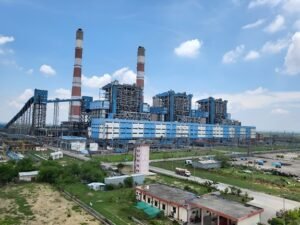Greater Noida (Hridaya Mohan): History has a rhythm and today, it beats to the sound of India overtaking Japan to become the fourth-largest economy in the world. This isn’t just a shift in global rankings — it’s a generational moment for a country that has long straddled the line between promise and performance.
In a quiet but historic announcement, the CEO of NITI Aayog, B.V.R. Subrahmanyam announced that India has overtaken Japan to become the fourth-largest economy in the world. “We are the fourth-largest economy as I speak. We are a USD 4 trillion economy, and this is not my data—it’s IMF data. India today is larger than Japan,” said Subrahmanyam during a press conference following the 10th NITI Aayog Governing Council Meeting. “Only the United States, China and Germany are currently ahead of us. If we stick to what is being planned and thought through, it’s just a matter of another 2 to 3 years before we become the third-largest economy,” he added.
The International Monetary Fund (IMF), in its World Economic Outlook report released earlier this month, stated that India is set to become the fourth-largest economy in 2025. India’s nominal GDP is projected to rise to $4,187.017 billion, surpassing Japan’s estimated $4,186.431 billion.
India continues to be the world’s fastest-growing major economy and is the only country expected to record over 6% growth over the next two years.
This rapid growth is expected to push India’s GDP to $5,584.476 billion by 2028, enabling it to overtake Germany and become the third-largest economy.
Japan, an economic powerhouse for decades, stands as a symbol of precision, innovation and industrial resilience. That India, with its complexity, contradictions and chaos, has now moved past it in GDP terms is both symbolic and substantive. It marks the arrival of a new chapter in India’s long journey of self-realisation.
The news may have broken without fanfare, but its significance is profound — not just for economists, but for every Indian who has lived the long arc of this country’s economic evolution. It is a reflection of resilience, reform and relentless ambition — of a democracy that, despite its complexities and contradictions, is now reshaping global economic narratives.
Milestone Decades in the Making
India’s ascent has been steady, driven by structural reforms that began in the 1990s and accelerated over the last decade. The rise didn’t happen overnight. It is the result of three decades of reform, ten years of digital transformation and the quiet work of millions of entrepreneurs, engineers, farmers, labourers and frontline workers. From digital payments to space missions, from start-ups to solar farms, India’s growth engine is now firing on more than just services. From GST and direct benefit transfers to digital public infrastructure like UPI and Aadhaar, policy tools have evolved to meet a young, ambitious, tech-savvy population.
The services sector remains a dominant force, but what has changed recently is the maturing of India’s manufacturing base and the explosion of its digital economy. India is no longer just the back office of the world; it is also a startup hub, a solar power leader and an emerging manufacturing destination. Manufacturing, once seen as a laggard, is showing renewed energy. Infrastructure is expanding at record speed. The digital economy has gone from buzzword to backbone.
From Numbers to People
Overtaking Japan, long regarded as an economic role model, carries symbolic weight. Japan has been admired for its innovation, discipline and quality of life. India, by contrast, still grapples with deep challenges — in health, education, urban planning and inequality. Our GDP may now be larger, but Japan continues to lead in per capita income and social indicators.
This milestone must therefore not make us complacent. Instead, it should spur us to match size with substance, and growth with dignity for all.
A Young Nation with a Long Horizon
India’s demographic advantage — with a median age under 30 — is unmatched. But it is also a ticking clock. This young nation is not only consuming more but creating more. India now ranks among the world’s top three startup ecosystems. Its domestic market, increasingly aspirational and digitally connected, provides scale that few others can match. To truly capitalize on this moment, we must generate not just jobs, but quality livelihoods; not just degrees, but skills.
Our future lies in investing in human capital, climate resilience and governance reform — in building a state that is nimble, inclusive and focused on long-term national interest.
A Moment for Reflection
But growth rankings tell only part of the story. India may be the fourth-largest economy, but it still ranks much lower in per capita income, healthcare access, and education outcomes. Millions remain vulnerable to inflation, job insecurity, and climate shocks. Bridging this gap between headline GDP and ground-level reality is the task that lies ahead.
Let us also not forget Japan’s economic journey — one defined not just by size but by stability, innovation, and quality of life. For India, surpassing Japan is not the end, but a milestone and a motivation. A bigger economy brings bigger responsibilities — to uplift, to include, and to sustain.
What’s Next?
Only Germany, China and the United States remain ahead of India in GDP rankings. Reaching the top three is no longer a fantasy — but the path will demand more than just economic growth. It will require unity, clarity of purpose, and sustained investments in health, education, infrastructure, and environmental sustainability.
The NITI Aayog announcement is a reminder: India is no longer a rising power — it has risen. But whether this rise translates into widespread well-being and global leadership will depend on what we do next.
The world is watching. So are 1.4 billion Indians — not just for economic milestones, but for a better, more equal tomorrow.
About the Author

(hridayamohan@yahoo.co.in)
Mr. Hridaya Mohan (hridayamohan@yahoo.co.in) is a regular Columnist with a renowned Indian daily “The Hitavada”, “Bharat Neeti Media” and some other newspapers / magazines internationally. Superannuated as Executive Director, Steel Authority of India Ltd. (SAIL), he is Senior Adviser, Metallon Holdings Pvt. Ltd. presently. He headed SAIL office at Beijing as Chief Representative (China & Mongolia) for six years. He has published and presented seventeen papers globally. Recipient of “Sir M Visvesvaraya Gold Medal”for one of his papers, “Benchmarking of Maintenance Practices in Steel Industry” from The Institution of Engineers (India), he was awarded with “Scroll of Honour” for the excellent contributions to Engineering fraternity from IE(I), Bhilai, “Jawahar Award” for leadership excellence in SAIL and “Supply Chain Leader – 2017” award from IIMM.









